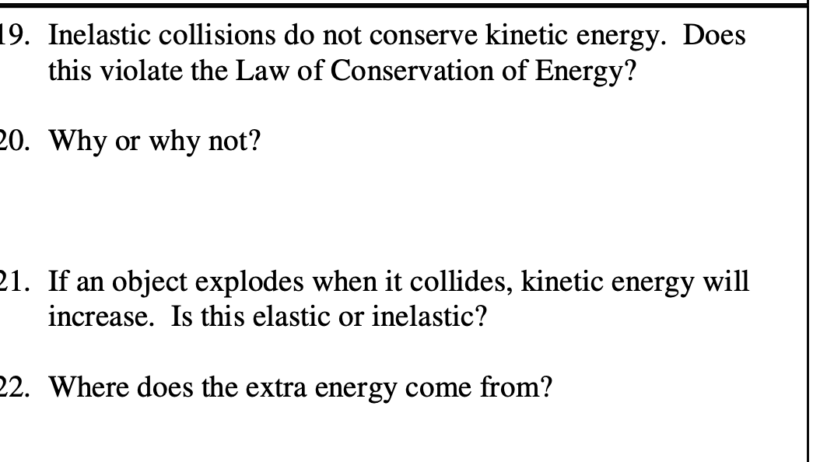When exploring the dynamics of collisions, one might ponder the age-old question: Do inelastic collisions conserve kinetic energy? This inquiry stands at the intersection of physics and energy conservation, offering insights not merely into the mechanics of moving bodies but also into broader implications for energy consumption and sustainability. Understanding the nature of inelastic collisions helps illuminate fundamental principles of momentum and energy while prompting a deeper reflection on how these principles can impact our environment.
To commence, let us define what is meant by inelastic collisions. Inelastic collisions are characterized by the phenomenon where two objects collide and subsequently stick together or deform, resulting in a loss of kinetic energy. However, it is crucial to note that while kinetic energy is not conserved in such events, momentum remains conserved. This juxtaposition raises intriguing questions about energy dissipation during a collision, often manifesting as sound, heat, or deformation of the objects involved.
The conservation of momentum principle states that in a closed system, the total momentum before and after a collision remains constant. This principle is pivotal in analyzing inelastic collisions, providing the foundation upon which we can assess the post-collision behavior of the objects involved. However, the violation of kinetic energy conservation in inelastic collisions prompts us to investigate the transformations that occur during such interactions.
During an inelastic collision, a portion of the kinetic energy is converted into other forms of energy. The deformations of the colliding bodies, resulting from the forces exerted during the impact, absorb a significant amount of kinetic energy. This absorbed energy subsequently transforms into internal energy, manifesting as heat or causing structural changes in the materials. The sound generated during the collision also represents another outlet of energy dissipation, revealing the multifaceted nature of energy transformation in inelastic interactions.
Mathematically, we can illustrate this contrast by employing the equations governing collisions. For two objects of mass m1 and m2 colliding at initial velocities v1 and v2, respectively, we can establish the momentum conservation equation:
m1v1 + m2v2 = (m1 + m2)vf
where vf is the final velocity of the combined masses post-collision. Conversely, the kinetic energy conservation equation, which fails in the case of inelastic collisions, can be represented as:
KEinitial = KEfinal
For elastic collisions, this equation holds true, but inelastic collisions yield discrepancies that highlight the transformation of energy rather than its conservation. The mathematical treatment of these scenarios elucidates the engineering and physical implications relevant to various fields, from automotive safety mechanisms to materials science.
Additionally, one cannot ignore the broader ramifications of understanding inelastic collisions within the context of energy conservation and environmental sustainability. As society grapples with the urgent demands for energy efficiency and conservation, insights derived from the study of collisions resonate with our need to assess energy expenditures in everyday life. The lessons derived from physical collisions underscore the importance of minimizing energy loss in numerous applications, from vehicular designs aimed at reducing collision impact to the engineering of buildings designed to withstand external forces.
Fascination with inelastic collisions also arises from their ability to serve as analogies for larger systems. For instance, consider the implications of inelastic collisions in the macroscopic world. The absorption of kinetic energy in collisions mirrors how energy inefficiencies permeate various sectors, from industrial processes to transportation systems. Real-world phenomena such as traffic accidents or natural disasters like earthquakes can be understood through the lens of energy dissipation elucidated in inelastic collision theory. Hence, expanding our comprehension of energy transformation can be instrumental in fostering innovations aimed at enhancing energy efficiency while minimizing detrimental impacts.
In education and practical applications, the mechanics of inelastic collisions provide a framework for hands-on experimentation. Students and researchers alike can engage in laboratory activities demonstrating the core principles underlying collision dynamics. By employing varying masses and configurations, one can famously illustrate the concept of momentum conservation while observing the telltale signs of energy dispersion, sound, and deformation during collisions. Such interactive learning reinforces comprehension, encouraging critical thinking regarding energy conservation and its practical implications.
In conclusion, while inelastic collisions unequivocally fail to conserve kinetic energy, the explorations surrounding them afford critical insights into both fundamental physics and broader societal challenges related to energy consumption and conservation. The dynamics of momentum present an intriguing counterbalance to the inexorable loss of kinetic energy in these interactions. Investing in a deeper understanding of inelastic collisions not only enriches our grasp of physics but also strengthens our commitment to devising innovative solutions for a sustainable future. The lessons reflected in the mechanics of inelastic collisions serve as an allegory for the energy challenges we face today, reminding us of the intricate yet delicate balance between energy usage and conservation. Ultimately, the study of these collisions transcends mere academic inquiry, challenging us to consider their implications on our environment and future energy endeavors.








